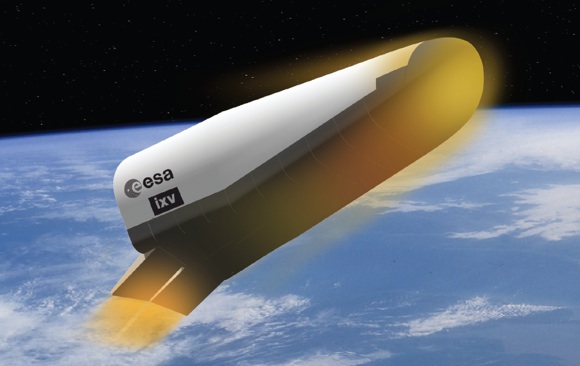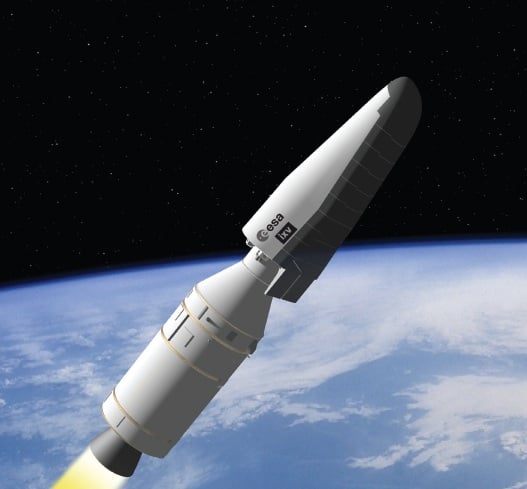This article is more than 1 year old
ESA to launch suborbital test spaceplane in 2013
Lifting-body robo ship to come down 'as if from orbit'
The European* Space Agency (ESA) has announced that it will launch an unmanned suborbital mission in 2013 designed to test various technologies which could be used in future on vehicles able to re-enter Earth's atmosphere from orbit and make a landing carrying cargo or personnel.

Lifting bodies back after nearly 30 years.
Originally it had been hoped that the Intermediate eXperimental Vehicle (IXV) could be launched into orbit and demonstrate accurate set-down on land using parachutes and airbags - the latter is particularly important in development of re-usable re-entry vehicles with reasonable costs. However, the ESA now says:
Launched into a suborbital trajectory on ESA’s small Vega rocket from Europe’s Spaceport in French Guiana, IXV will return to Earth as if from a low-orbit mission...The 2 t lifting body will attain an altitude of around 450 km, allowing it to reach a velocity of 7.5 km/s on entering the atmosphere. It will collect a large amount of data during its hypersonic and supersonic flight, while it is being controlled by thrusters and aerodynamic flaps.
The craft will then descend by parachute and land in the Pacific Ocean to await recovery and analysis.
This represents fairly limited ambition by the ESA in some ways. The US Air Force is currently flying a small robot spaceplane (the X-37B) which can not only come down on land but set down on a runway. Elon Musk's famous company SpaceX, a relatively tiny organisation, has lately sent its Dragon capsule into full Earth orbit followed by ocean splashdown, and intends soon to demonstrate accurate setdowns ashore.
But the ESA isn't just playing catchup: it is also going its own way in one respect. The IXV will use a lifting body rather than the delta wings employed on the Shuttle, the X-37B and the Soviet Buran - all the human race's orbital spaceplanes thus far.
It was argued during the development of the Shuttle that it should have been a lifting body rather than a delta-wing job: the advocates of lifting bodies contended that this would have let it carry more payload and still set down on a runway after an orbital flight. However the US military, which was helping to pay for the Shuttle, wanted to fly missions in which it would land at locations well off its orbital track and thus would need the ability to glide "cross range" during its descent using large wings**.

Up diddly up up
Now lifting-body spaceplane tech seems set to go back into space again for the first time since the Soviet BOR-4 tests of the early 1980s. The information developed from the IXV mission may mean that future spaceplanes will look more the way some people wanted the Shuttle to.
ESA officials - perhaps a little sad at having just purposely hurled their €450m+ Johannes Kepler space caro-ship into the atmosphere to burn up - are plainly hoping that IXV will evolve in time to produce a fully reusable craft which can set down on land - perhaps even on a runway one day.
"The IXV mission into space has become a near-term reality. Its success will provide Europe with valuable know-how on reentry systems and flight-proven technologies that are necessary to support the Agency’s future ambitions, including return missions from low Earth orbit,” says Giorgio Tumino, IXV project chief.
“In the long term, studies on the evolution of IXV will be consolidated and proposed to Member States, focusing on an affordable reusable craft for operating and servicing payloads in orbit before returning to touch down on land.” ®
Bootnotes
*Lest anyone should think that the ESA is an agency of the European Commission or Union, it isn't, though it does work closely with Brussels. The ESA governing council includes various non-EU nations such as Switzerland and Canada, and not all EU nations are ESA members.
**In the end the planned, undetectable one-orbit spysat-dropoff/return missions never happened as the Shuttle lacked the grunt to lift heavy surveillance satellites into the necessary high-angle orbits. There were plans for extra strap-on boosters, but the Challenger disaster delayed the Shuttle so much that the military and spooks got sick of it and moved in large part to using ordinary rockets.
